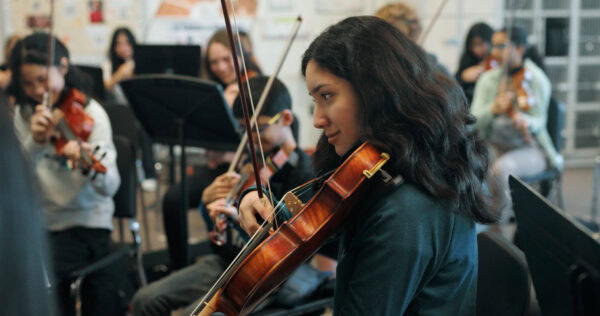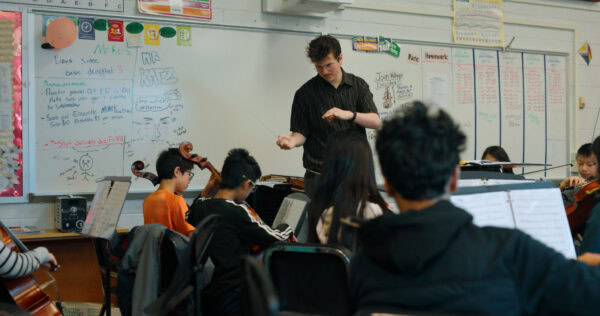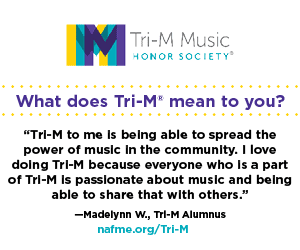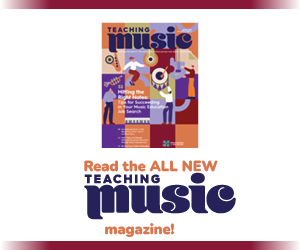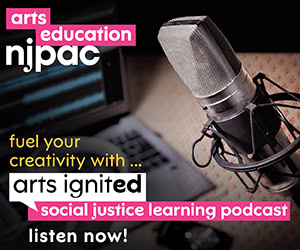/ News Posts / Why Music Education Is Essential in the Age of AI
The Creative Imperative
Why Music Education Is Essential in the Age of AI
By Anton Krutz, sponsored by NAfME Corporate Member Krutz Strings
We stand at the cusp of a technological revolution driven by rapidly evolving artificial intelligence (AI). Experts predict the emergence of Artificial General Intelligence (AGI)—AI capable of human-level learning and reasoning—by 2028, with the potential for self-aware, superintelligent AI by 2030. This raises critical questions about the future of work and humanity’s role in an increasingly automated world.
AI is already starting to quickly replace many jobs. The potential for widespread job displacement is a significant concern. Proactive measures are crucial to avoid societal disruption. While AI excels at data processing, repetitive tasks, and mimicking certain creative aspects, it lacks true human creativity. This is our defining advantage.
True creativity involves envisioning the nonexistent, connecting disparate ideas, and navigating dynamic environments using intuition and emotional intelligence. In the age of AI, creativity will be the most valuable human asset. Those with strong creative skills will leverage AI as a tool for innovation, problem-solving, and shaping the future. Those less creatively inclined risk being left behind. How do we cultivate this essential human capacity? The answer lies in music education, specifically training on acoustic instruments.
The Power of Music: A Catalyst for Creativity
Music training, especially with acoustic instruments, is a powerful cognitive workout. Research demonstrates its profound impact on brain development, enhancing plasticity, memory, IQ, abstract reasoning, mathematical skills, problem-solving, planning, attention to detail, fine motor skills, emotional regulation, language skills, and crucially, divergent thinking—a cornerstone of creativity.
Music’s connection to cognitive development is well-established, but its specific link to creativity deserves emphasis. Music training fosters five key drivers:
- Continuous Question-Flow: Playing an instrument requires constant monitoring, adjustment, and anticipation, creating a cognitive state of continuous questioning essential for both musical performance and creative problem-solving.
- Engaged, Expanded Emotion: Creativity requires both intellect and emotion. While other subjects engage intellect, the arts, particularly music, uniquely engage and focus emotions, fueling the creative process.
- Enhanced Brain Networks: Music training strengthens brain networks responsible for decision-making, focus, and impulse control through changes in white and gray matter.
- Sensory-Motor Integration and Collaboration: Musicians integrate sensory (auditory) information with motor skills, developing precise control and coordination, translating into enhanced group collaboration.
- Accelerated Brain Maturation: Music training accelerates the development of brain areas related to sound processing, language, speech perception, reading, and time management, crucial during adolescent brain development.
The neuropsychological principle of “what fires together, wires together” underscores music training’s impact. No other activity engages so many brain regions simultaneously, creating such robust cognitive structures.
The Emotional Core of Creativity
Music extends beyond cognitive benefits to the emotional realm. Symphonic music powerfully evokes a wide range of emotions, explaining its effective use in film and gaming. The vibrations from acoustic instruments are key, inducing and stimulating emotions. Vibration characteristics determine the emotion evoked: fast/high vibrations often induce positive emotions, while slow/low vibrations can evoke negative ones.
This emotional connection is crucial for creativity. Passion fuels the intellect of successful creative individuals. Similarly, emotions induced during music training stimulate brain rewiring and maximize creative benefits, creating a self-reinforcing loop: Music training stimulates emotion, which enhances creativity, which improves cognitive abilities and musical performance.
A Vision for the Future: Music as an Essential Skill
We must shift our perspective and view music programs as organizations. The “what” they produce is skilled musicians; the “how” is their teaching. But the essential “why” is their contribution to society. While valued, music programs are often considered optional. The connection between music training and creative potential provides a new vision: Music programs are essential for navigating the future.
In a technology-driven world, creativity will be the ultimate differentiator. Adaptability, innovation, and creative thinking will be paramount as technologies reshape industries. Information and hard skills will become rapidly obsolete. The only sustainable human advantage will be creativity. A “growth mindset”—constant self-growth and adaptation—will define success. As Einstein noted, a society’s advantage comes from stimulating imagination and creativity, not rote memorization.
During this transition, music programs will be crucial anchors in education, fostering students’ creative thinking. Therefore, we propose this vision:
Music programs are platforms that develop a student’s creative potential for self-growth and ability to adapt to societal change.
The mind continually adapts the brain through neurological wiring, favoring either creativity or conformity. This ongoing process shapes the brain with every thought, word, and action. A brain geared toward creativity, associated with a “growth mindset,” develops diverse neural pathways across multiple brain regions (neuroplasticity), enabling flexible information processing. In contrast, a brain geared towards conformity, often fostered by current education systems, develops more localized and uniform neural pathways, optimizing inflexibility in the transmission of information.
In the future, music training will be recognized as a required “cognitive workout,” essential for success in all fields. In the age of AI, cultivating creativity through music is not just beneficial; it’s imperative for individual and societal flourishing.
Conclusion
The convergence of rapid AI advancement and the enduring power of music education presents a compelling case for prioritizing a student’s creative development. While AI excels in processing data and automating tasks, it lacks the uniquely human capacity for true creativity, fueled by emotion, intuition, and divergent thinking. Music training, particularly with acoustic instruments, acts as a potent catalyst for these essential creative skills, fostering cognitive development, emotional engagement, and enhanced brain networks.
By recognizing music education not merely as an artistic pursuit but as a crucial cognitive workout, we equip individuals with the adaptability, innovation, and creative problem-solving abilities necessary to thrive in a rapidly changing, technology-driven world. Embracing this vision—that music programs are platforms for cultivating creative potential and adaptability—is not just beneficial; it is essential for individual and societal flourishing in the age of AI.
For more in-depth information visit: Music-Advocacy.com
About the author:
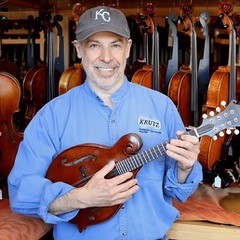 Anton Krutz is a renowned luthier whose instruments are highly valued by professional musicians globally. The exceptional sound quality of KRUTZ instruments, made with unparalleled craftsmanship, has made them sought after by performers of the highest caliber, solidifying his reputation within the musical community. In addition to his artistry, Krutz is a successful entrepreneur and a thinker engaged in diverse intellectual pursuits, including physics, neuroscience, sociology, innovation, and education, which have contributed to his understanding of empowering creativity and music advocacy.
Anton Krutz is a renowned luthier whose instruments are highly valued by professional musicians globally. The exceptional sound quality of KRUTZ instruments, made with unparalleled craftsmanship, has made them sought after by performers of the highest caliber, solidifying his reputation within the musical community. In addition to his artistry, Krutz is a successful entrepreneur and a thinker engaged in diverse intellectual pursuits, including physics, neuroscience, sociology, innovation, and education, which have contributed to his understanding of empowering creativity and music advocacy.
Interested in reprinting this article? Please review the reprint guidelines.
The National Association for Music Education (NAfME) provides a number of forums for the sharing of information and opinion, including blogs and postings on our website, articles and columns in our magazines and journals, and postings to our Amplify member portal. Unless specifically noted, the views expressed in these media do not necessarily represent the policy or views of the Association, its officers, or its employees.
Published Date
February 18, 2025
Category
- Innovation
- Lifelong Learning
- Social Emotional Learning
- Technology
Copyright
February 18, 2025. © National Association for Music Education (NAfME.org)

